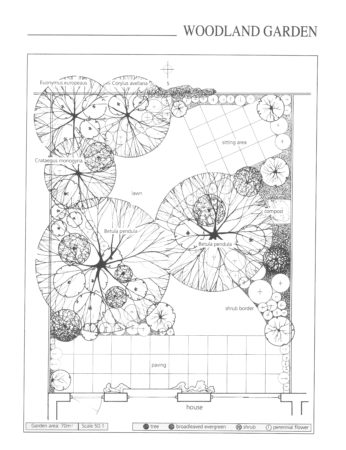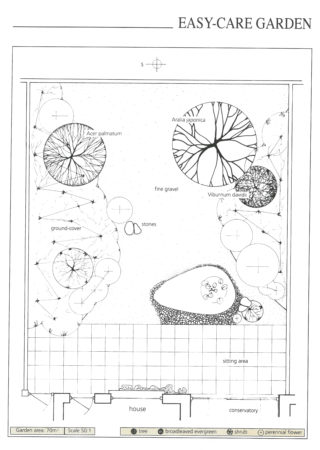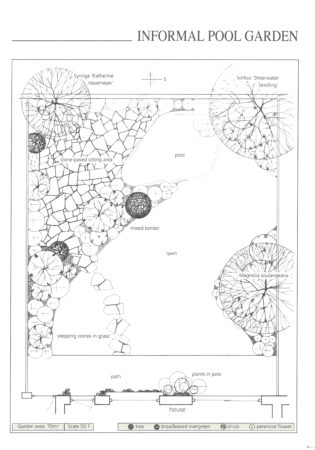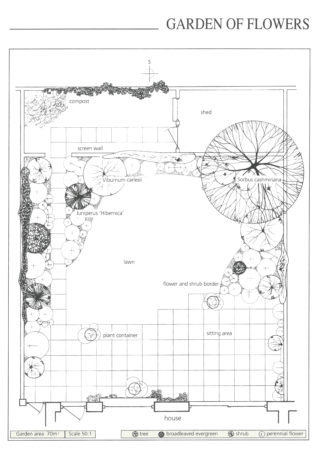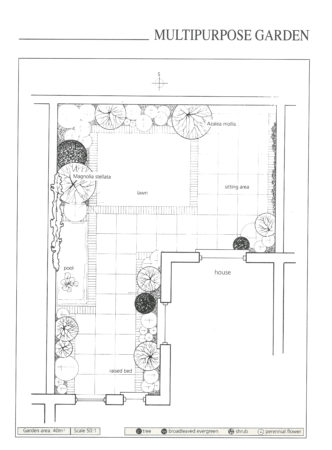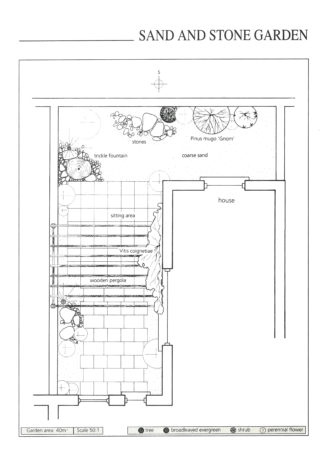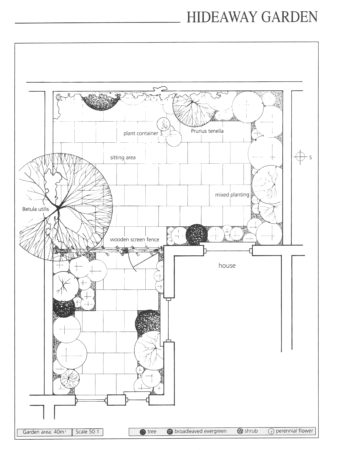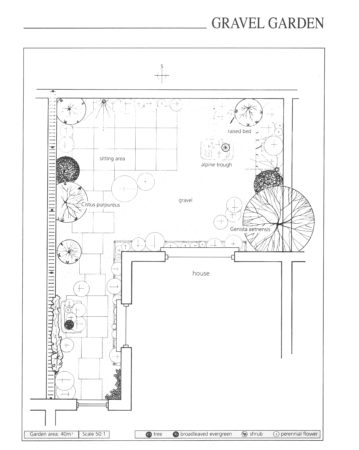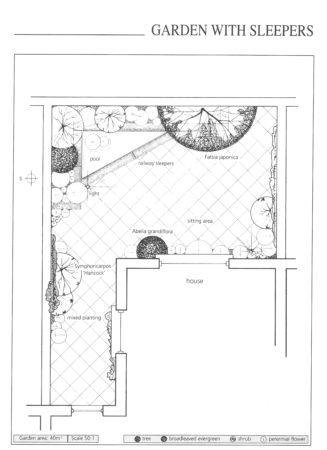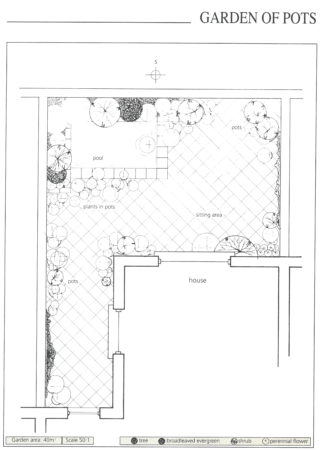Post category: Garden design
Assessment:
Wooden fences (1.8m high), garden faces north, overlooked. Trees are a priority.
Case Study No. 4
Click here to view bigger sized drawing
Hard landscaping:
An area of 60 cm square concrete paving slabs links the back of the house to the garden. A second small sitting area is hidden by planted borders on each side of the garden. Most of the garden surface area is taken up by these wide borders.
Planting:
The paved areas are linked by a curving lawn that takes its shape from the two borders. These are planted with five small to medium standard trees. Underneath these are shade tolerant shrubs and perennial flowers. At the edges of the paving where the borders finish, there are annual bedding plants to provide colour.
Garden style:
An informal style with strong emphasis on woody plants because these are a priority here. Even in a small garden it is possible to create a woodland feeling by using a good number of trees and planting shrubs to hide the boundaries.
The curving borders disguise the length of the garden and give the impression of greater size. The garden will be shaded but this is part of the required style. The lawn will tend to be mossy because of the shade, but this is also in keeping with the style.
Maintenance and cost:
Very little maintenance once established; some mowing, weeding and leaf raking. An inexpensive garden, just plants and the cheapest paving. Semi-mature trees might be used for quick effect.
Assessment:
Medium height walls, garden faces west, somewhat overlooked all round.
Hard landscaping:
Most of the surface area is covered with a layer of at least seven centimetres of fine gravel. This area has curved edges and is bounded by gently sloping borders, rising thirty centimetres above the general garden level at the walls. Part of the garden is paved with 40 cm square concrete paving slabs. The walls are smooth, plastered and painted.
An informal (2.5m x 1.5m) pool is lined with a flexible liner that is covered with fist-sized stone cobbles to hide it. Two sets of two large stones are placed where they contrast with the gravel and the planting. The gravel, cobbles and large stones should be all the same type of rock.
Planting:
Most of the planted area is covered with ground cover plants. Some trees feature as specimens, and to provide some privacy. A few well-chosen shrubs and perennials provide year-round interest. In the gravel for contrast, one spiky plant, and a flat one near the pool.
Garden style:
An informal modern style. This style relies on the value of the shape and texture of plants and hard materials. The flat gravel and sloping borders create an illusion of space. Smooth walls set off the plant shapes.
Maintenance and cost:
Practically no maintenance; just occasional raking, and weeding until ground cover is established. Relatively inexpensive; only the paving adds significantly to cost.
Assessment
Wooden fences (1.8m high) and walls, garden faces east, overlooked from second storey on most sides.
Case Study No. 2
Click here to view bigger sized drawing
Hard landscaping:
An informal pool and associated paved area are the dominant features. Stone paving is laid in irregular pattern to complement the informal lines of the garden. The pool (3.25m x 2.25m) would be lined with a flexible liner.
The paved area is placed away from the shadow of the house. Stone paving laid as ‘stepping stones in grass’ across the lawn avoids wear, and links the paved area to the house without upsetting the informality of the garden. Flower borders flank the lawn on three sides.
Planting:
The surface area is mostly covered by a lawn with edges in sweeping curves. Three small trees are used to frame the garden, ‘lift’ the walls and provide privacy. Mixed planting between the paved area and the lawn screens off that corner. The borders with trees have shade-tolerant plants. Containers with annual plants help to decorate the concrete path beside the house.
Garden style:
An informal style with flowing curves and materials that have no strong pattern. The partial division by the central border creates curiosity and adds interest. It makes the paved area feel safe and comfortable for sitting.
Maintenance and cost:
Relatively easily maintained; mowing and some weeding, not demanding in terms of neatness. Moderately expensive; the stone paving is relatively expensive, and the pool would also add to the cost.
Assessment:
Medium height walls, garden faces south, not particularly overlooked, flowers and colour a priority. Problem – to hide a garden shed.
Case Study No. 1
Click here to view bigger sized drawing
Hard landscaping:
Garden sheds, oil tanks, coal bunkers and dog kennels tend to spoil small gardens. A ‘false’ wall of concrete screen blocks is used here to hide the garden shed and compost / service area.
The surface area is partly paved with 40 cm square concrete paving slabs. A service path leads from the paved area and is flanked by two flower borders. The slabs step out two courses into the lawn area to break the line of paving and to make a wider sitting area. A curving border surrounds the lawn on its other sides. Three clay pots break up the expanse of paving.
Planting:
Lawn covers most of the surface area. One small standard tree provides some privacy for the sitting area and helps to ‘lift’ the flat lines of the walls. Climbers help too. The borders are planted mostly with perennial flowers and some shrubs, including evergreens, for year round structure. The pots contain bedding plants for colour and variety. The borders hide the path; a pillar-shaped tree helps to disguise the entrance to the service area.
Garden style:
An informal style suitable for growing a wide range of plants, especially perennial flowers. Good use is made of the vertical space of walls and the flat surface area of the garden is not broken up unnecessarily.
Maintenance and cost:
Considerable maintenance; mowing, weeding, tidying. Not expensive; only the false wall and paving would be costly.
Assessment
Medium height walls, garden faces south.
Case Study No. 7
Click here to view bigger sized drawing
Hard landscaping:
Most of the surface is paved with 60 cm square grey or buff concrete slabs edged with red bricks laid on their edge. An area of ground for a lawn is edged all round with brick to provide a mowing strip. A rectangular pool is also edged with brick.
The same bricks make up the edges of a number of beds and borders. These are all at the level of the lawn and paving except those on either side of the back door, which are raised by fifteen centimetres. Lamps are placed near the pool for reflections at night.
Planting:
Although most town gardens are best paved to resist wear and tear, many people like to have a small patch of lawn. A mixture of shrubs, some broadleaved evergreens, and perennial flowers are used in the beds and borders to contrast with the even surface, and colours, of lawn and paving. There are some climbers on the walls.
Garden style:
A traditional semi-formal style with rectangular shapes strengthened by the use of brick edging. The pool would need to be made of concrete to ensure a solid foundation for the brick edging. This garden would be suitable for children if the pool was used as a sandbox. The lawn could be taken out and paved if it became a bother.
Maintenance and cost:
Some maintenance required, lawn to be cut. Relatively inexpensive garden, cheap paving. The pool and lighting would add to the cost.
Assessment
Medium height walls, garden faces south, most space to the side of the house but it is overlooked.
Case Study No. 6
Click here to view bigger sized drawing
Hard landscaping:
Most of the surface area is covered with coarse sand to a depth of at least seven centimetres. Part of the area is paved with 40 cm square concrete slabs and forty by 60 cm square slabs in alternating, staggered courses. The paving could be grey, brown, red or buff in colour to suit the sand and stones.
Groups of large and small stones are used to contrast with the fine texture of the sand. A drilled stone with a trickle fountain features at the centre of one of the groups of stone. This would have a catchment pump and circulation pump.
A pergola of stained, or painted boards (25 x 5 cm) set thirty centimetres apart provides screening from being overlooked. It does not cover the south-facing part of the paved area. Lamps are located near two groups of stones to highlight them at night.
Planting:
Very few plants are used. There is a climber on the pergola and house wall. A handful of shrubs and perennial flowers of dramatic shape and foliage provide contrast with the texture of stone, sand and paving.
Garden style:
A very informal style, the emphasis is on the shape and texture of hard materials and plants.
Maintenance and cost:
Almost maintenance-free, occasional raking. Relatively inexpensive; not much paving. Pump, pergola and lights would add to the cost.
Assessment:
High walls surround the garden. Faces east, overlooked from the northwest.
Case Study No. 5
Click here to view bigger sized drawing
Hard landscaping:
The garden surface is paved with 60 cm square concrete paving slabs laid square in staggered courses. A generous border is left around the walls except beside the sitting area. An open screen fence of dark stained, or black painted, boards (25 x 5 cm) divides the garden to the height of the walls. It has a doorway.
The screen fence cuts off the view from the northwest but it is angled to allow a view of the garden from the small window. One wide, low concrete container provides ornamental interest on the paved area.
Planting:
A small standard tree (3 metre spread of branches) provides screening from a higher level, complementing the wooden screen. A mixture of shrubs and perennial flowers fills the borders and, in some cases, spills out onto the paving to soften its hardness. Climbers decorate the walls and, by being taller, the tree helps to ‘reduce’ their height.
Garden style:
An informal style, there are no strong geometric shapes. The paving forms a strong, but informal, pattern, and its flatness emphasises space. Suitable for children.
Maintenance and cost:
Easily maintained; occasional tidying. Inexpensive; cheap paving, wooden fence. No pool or ornaments, except one container.
Assessment:
Medium height boundary walls, garden faces south, overlooked from the east.
Case Study No. 4
Click here to view bigger sized drawing
Hard landscaping:
The garden surface is laid down to gravel with 60 cm square concrete paving slabs set into it to make a small paved sitting area and a path. A raised (30 cm) bed on the south side of the garden lifts plants to the light and provides drainage. A narrow bed around the base of the house walls links the house to the garden.
Two stone troughs can be seen from the windows. An open screen fence of white painted boards (15 x 2.5 cm) on top of the wall provides effective screening without excluding light. Lamps would give dramatic night-time effects.
Planting:
Plants that prefer dry conditions because the garden is warm and sunny. The sunniest position is given to the plants; the paved area being moved into the shadow of the end wall. Shrubs and perennial flowers of Mediterranean origin are used around the walls, alpine plants in the raised bed and narrow bed. There are alpines in the troughs and also planted through the layer of gravel and allowed to spread over it.
Garden style:
An informal style using hard materials of informal shape and plants to set them off. Some plants of strong shape, for example spiky types, would set off the gravel.
Maintenance and cost:
Easily maintained; occasional watering. Relatively inexpensive; gravel is cheap, but real stone troughs and lighting would add to the cost.
Assessment:
High boundary walls on all sides, garden faces west.
Case Study No. 3
Click here to view bigger sized drawing
Hard landscaping:
The entire area of the garden is paved with 40 cm square concrete slabs laid diamond pattern. The concrete slabs could be grey, red or yellowish in colour. A narrow bed beneath the large window links the house with the garden, and a second one provides interest from the small window.
The shaded corner has a raised (20 cm) pool made of railway sleepers, two high, and a raised bed at the back, four sleepers high. The pool is lined with butyl rubber, taking its shape from the sleepers. There are low level bollard-style lamps to light the garden at night.
Planting:
The plants in the shaded part are shade-tolerant, broadleaved evergreen shrubs and ferns. The ornamental beds have some shrubs, perennial flowers and provide rooting for the wall climbers. One broadleaved evergreen tree provides a counterbalance to the strength of the sleepers. Plants should be mostly green.
Garden style:
A semi-formal style with strong rectangular and triangular shapes provided by the sleepers. They also provide strong texture and dark colour. Paving could be grey or reddish, toned down by the dark evergreens.
Maintenance and cost:
Easily maintained; occasional tidying. Not expensive; cheap concrete slabs and sleepers, lighting would add expense.
Assessment:
High walls on all sides, garden faces south.
Case Study No. 2
Click here to view bigger sized drawing
Hard landscaping:
The entire area is paved with thirty centimetre quarry tiles to create a feeling of space. There is an ornamental pool that is edged with quarry tiles and a border on two sides of the pool. This is raised about ten centimetres above the level of the paving and pool edge.
Roughly twenty five clay pots of various sizes are used for their own ornamental value and to hold plants. The corner opposite the pool has been left unpaved as a small corner bed.
Planting:
A variety of shrubs, perennial flowers and some bedding plants are used to soften the flatness and uniformity of the tiles. Most of the planting is permanent but some of the potted plants and the bedding plants will be replaced twice each year.
The potted plants are used in groups to set each other off – shrubs and perennial flowers for permanent shape, annuals for colour. There are some climbers on the walls.
Garden style:
A semi-formal style using diamond pattern paving, a rectangular pool and circular pot shapes. This would be quite plain without the informality of the groupings of pots. The pool is partly obscured by a grouping of pots.
Maintenance and cost:
Considerable maintenance; watering pots. Relatively expensive; tiles and formal pool would be best made of concrete, which is costly.
Assessment
High boundary walls (2m) all around, garden faces south.
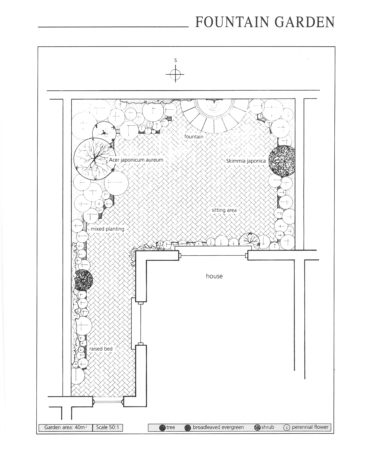
Case Study No. 1
Click here to view bigger sized drawing
Hard landscaping:
The entire surface area is covered with concrete paving bricks except for borders that run around most of the length of walls. The borders are edged with an ornamental raised (10cm) coping that is curved at the corners.
There is a curved basin and wall fountain. The coping and basin surround could be of grey or buff concrete, or natural stone cut to shape. A small circulating pump could be installed in the bottom of the basin.
Planting:
The plants are mainly perennial flowers with some ferns in the shade of the walls to soften the formality of the hard materials. A few shrubs, including a couple of broadleaved evergreens, give the planting some permanence for the dormant season. Some climbers should be used to soften the walls and make use of the vertical space.
Garden style:
A formal style with the use of formal circles in the border edges and the water feature. The basin fountain cannot be seen until the corner is turned. Because of their small size, paving bricks create an impression of greater space, as does the herringbone pattern.
Maintenance and cost:
Easily maintained; needing only occasional tidying. This would be reasonably expensive because of the amount and type of paving, and the ornamental basin.
Town gardens
Size: Town gardens tend to be small in size, twenty to about eighty square metres. If larger, they can be treated as small suburban gardens. Generally, they have no view to the outside.

Garden Size
Click here to view bigger sized image
Problems: Small size, high walls, noise, air pollution and lack of privacy.
Small suburban gardens
Size: Small suburban back gardens are usually about seventy square metres to about two hundred. Generally, they look onto the backs of other houses and rarely have a view to be retained.

Garden Size
Click here to view bigger sized image
Problems: Small size, bare walls, noise, lack of privacy.
Large Suburban gardens
Size: Large suburban back gardens range from about two hundred square metres to 1,000 square metres. Larger than this, they can be treated as country gardens from a design point of view.

Garden Size
Click here to view bigger sized image
Problems: Usually narrow compared to their length, maybe overlooked, rarely have views worth retaining, poor boundaries – usually fences and hedges, sometimes walls.
Country gardens
Size: Many country gardens are 1,000 square metres or more in extent. Smaller than this, they can be treated as suburban gardens in terms of design size.
Problems: Generally large, costly to fill and difficult to maintain, rarely overlooked, often with good views but may be exposed. Long boundaries to be disguised.
Good garden design aims to use space well. Open areas of lawn, paving or water give a sense of space. To enjoy the garden and its views, adequate space is very important, but space also has its own quality.

Garden Space
Click here to view bigger sized image
Some garden areas have a remarkable ‘feel’ about them, just as rooms in a house are described as ‘pleasant’. The way the garden space is divided largely determines the ‘feel’ of the garden, and how comfortable we are likely to be.
Perception
The proportions and dimensions of the garden, or its divided parts, affect our perception of the space. A long, narrow space feels uncomfortable, likewise a very broad space. It is essential to divide the ground area of the garden to get better proportions.
The height and ‘weight’ of plants and other objects, affect our sense of space. Tall trees can cause a reduction in our perception of the space of a garden without encroaching on the actual space. Likewise, tall deciduous trees are unlikely to cause as great a reduction in perceived space as ‘heavier’ conifers or broadleaved evergreens.
Size
It is interesting to have spaces and objects of different sizes in a design. Without being conscious of it, our eyes constantly record and analyse the size of spaces and objects. Size is measured in three dimensions – length, width and height. Every object and feature in the garden, plant or non-living part, has a measurable size – small, medium or large, and many stages in-between.
Objects like garden slabs, or a seat, are of a fairly precise size. The size of plants, both large and small is impressive; a range of size creates more of an impression – more to analyse. The eventual size of plants varies considerably depending on the soil and site conditions, but they are reasonably predictable.
For example, an oak tree can be expected to become large. It is very useful to have a notion of the size of the units of measurement – one foot, ten feet; one metre, ten metres – both horizontally and vertically.
Proportion
Our impression of the size of any object or plant is relative to other objects nearby. In a newly planted garden, a two-metre high shrub looks large, but the same shrub would be less significant in a garden with large trees. Our eyes measure size, or proportion, at a glance.

Garden Space
Click here to view bigger sized image
It is important to have everything in the garden in balanced proportion. This is true of the garden spaces as well as its features and objects. A very large tree in a small garden looks wrong; equally, isolated small shrubs look wrong in a large garden.
The relationship of the size of objects, and the space they occupy, must be pleasing to the eye. Things must be kept in scale. A little bed of flowers tucked away at the bottom of a large lawn is lost; a little pond in a large lawn is no more than a puddle.
Perspective
Far away objects appear smaller. Although an object like a summerhouse looks large close to, it might appear very small and inconsequential at a distance. The size of such objects needs to be considered in the perspective. Bringing it closer might solve the problem.

Garden Space
Click here to view bigger sized image
The effect can be used to give a garden a false sense of space. Since we expect things in the distance to be smaller, placing small objects and plants at the end of the garden will create an illusion of greater length. The opposite effect can be used to make a garden look shorter.
Weight
Although the dimensions of two objects might be identical, they can be of different weights. For example, a shrub does not have the same weight or mass as a boulder of the same size. We know this just by looking at the boulder. It has a ‘massive’ look to it.
The weighty solidity of hard materials such as paving and walls is one of the reasons that they are so important in the garden as contrast to the lighter living plant material.
Some plants seem to have more weight though they would not physically weigh more. Trees with large dark green leaves look ‘heavier’ than those with more open foliage. For example, lawson cypress is heavy, birch is a light tree. Conifers and broadleaved evergreens tend to be weighty plants; they can be used to good effect in winter among deciduous plants that look distinctly ‘light’ when their leaves are off.
There are many kinds of shape and form, and as many words to describe them. Hard materials can be described as round, square, diamond-shaped, oblong, and rectangular. Plants can be described as pyramidal, pillar, column, fastigiate, flat, prostrate, drooping, weeping, and trailing.

Shape and Form
Click here to view bigger sized image
Outline
Although the three basic dimensions of size, length, width and height, give an indication of the shape of an object, its characteristic outline or form is much more complex. More than anything else, we recognise an object by its outline; shape first, then colour and texture. A black and white photograph has no colour but is still instantly recognisable. Even a silhouette is enough.
Subconsciously, our eyes and brain constantly analyse the shapes that surround us. An interesting garden should be a combination of interesting shapes – a richness to delight the eye.
Garden shape
The shape of the garden is defined by the shape of the ground, the walls, hedges and fences that divide it up, and the plants that decorate it. The basic shape of the garden, formed by the ground shaping and hard materials, must be pleasing in its own right before any plants are added.
For example, a garden site with slopes, terraces, ornamental walls, trellis, water feature, and paved areas would be interesting before any plants are put in.
Plant shape
Although the shape of plants is their most important ornamental feature, it is usually the one least taken into account in choosing them for the garden. The characteristic outline of each plant is unique and ought to be considered carefully. The various shapes should be used in combination to create interesting pictures.
Using plant shape
Plant shapes vary from horizontal (prostrate on the ground) to vertical (narrow upright pillar). The other plant shapes are between the extremes. Rounded shape, for example, has about the same amount of each dimension, tall as wide. The shape of plants can be used in two ways; to accentuate similar shapes, or to contrast with opposites.

Shape and Form
Click here to view bigger sized image
When using plants to accentuate the shape of other garden objects, the idea is to ‘pick up’ the dominant lines of the shape to be emphasised. The horizontal lines of the roof of a house might be mirrored by flat-topped trees or shrubs at a different level.
Trees of columnar shape could be used to emphasise the vertical lines of the house walls. For example, a flat-growing conifer placed at the corner of a house contrasts with the vertical of the wall, while a small tree of columnar shape emphasises it.
Many plants are of rounded, or conical shape and these are very useful for contrast with the rectangular shape of houses, walls, fences, trellis, paths and paved areas. Rounded and conical shapes are of varied height and width.
Considerable added interest can be built into the design by using various rounded, or conical, shapes in association with each other. Since so many plants are of intermediate rounded or conical shape, this effect usually happens when choosing plants for other reasons, but it is no harm to bear it in mind.
Everything in the garden picture provides colour, including the sky in the background. Although we often use the words ‘flowers’ and ‘colour’ interchangeably, it is a mistake to think that flowers are the only source of garden colour.

Sources of Colour
Click here to view bigger sized image
The most important garden colour is the green of leaves. A garden with green trees, shrubs and herbaceous plants, and a nice background of blue sky, can be beautiful without a single flower. The amount of sky seen, and the shape of the skyline as viewed from the garden, can be defined by the choice of trees used. There isn’t much we can do about the sky’s colour!
The colours of the hard materials of the garden contribute to the overall result. These must suit each other and the house, and they will have some influence over the choice of plants. For example, grey, brown or buff-coloured paving will suit any plant colour – green, grey, pink, blue, yellow, white, lime-green, bronze or purple.

Sources of Colour
Click here to view bigger sized image
Dark-green leaves might make grey paving look leaden while grey and silver foliage will ‘lift’ it. Lime-green and bronze look great with yellow, or buff paving. Red paving might not combine happily with certain shades of pink, orange or red. Similarly, the colour of walls can influence the choice of other materials and plants.
Additional colour sources are fruits and berries, bark and twigs, stems and buds, seed heads. These are very varied and though not major contributors, they are most important in autumn and winter when foliage and flowers are scarce.
The green pigment chlorophyll, which traps the sun’s energy, is present in every leaf. It sets the underlying colour of plant foliage. The amount of chlorophyll present changes the quality of the green colour. The range of greens – the dark-green of broadleaved evergreens to the yellow-green of beech in May – is enormous.

Foliage Colour
Click here to view bigger sized image
As well as the green pigment, there can be red, purple, yellow and orange pigments in the leaves. The combination of these pigments gives coloured foliage; red, purple, bronze, brown, yellow, golden, lime. The withdrawal of the green pigment by plants before the leaves fall in autumn brings about the autumn colour change when the associated ‘masked’ pigments are more dominant.
Another set of foliage colour types comes from the adaptations of plants to resist heat and cold. Leaves covered with fine hairs take on a grey or silvery appearance. Those which cover themselves with wax take on a blue or grey colour.
Mutant forms of plants that have the green pigment in only part of the leaves provide variegated leaf colour. This might be white variegation if there is no yellow pigment present, or yellow variegation if there is.
It is easy enough to mix leaf colour because the common colour green helps them to blend. ‘Ordinary’ green should be by far the most dominant foliage colour with lesser amount of the other colours; gold, bronze, purple. In particular, variegated foliage should be used sparingly, if at all. Too much variegation is gaudy and unnatural.
It is much better not to use strong contrasts, such as golden variegation with strong blue. Variegated foliage is best with ‘ordinary’ green to tone it down. Blue foliage goes well with silver and grey, and perhaps some ‘purple’.
Flowers provide a huge range of colour; different shades, tones and tints of red, orange, yellow, green, blue, indigo and violet – all the colours of the rainbow. Tints are made by adding white to the primary hue; tones by adding grey; and shades by adding black.

Flower Colour
Click here to view bigger sized image
The colour of flowers also varies in intensity, depending on how much pigment is present. This can change during the life of the flower, usually increasing after opening from the bud before fading again.
Flower colour must always be considered with the surrounding foliage and flowers in mind. These can influence how a colour is perceived. White flowers of magnolia will be lost against a pale grey sky in spring, but look dramatic against a dark backdrop.
There is enormous challenge, and satisfaction, in placing flowers to best colour effect with the right foliage and flowers. The result is much greater than the sum of parts. Sometimes, these happy combinations, or associations, occur accidentally, but usually they need to be thought out carefully, worked out by trial and error, or simply copied from photographs or other gardens.
For a colour combination to work, the plants must flower together, and they must be planted so that the lower types can be seen. Flowering times vary slightly each year and sometimes upset well-laid plans. Foliage plants are more predictable than flowers and last longer. Used together with flowers in these associations, they add subtle effects of their own.
In every garden design, there will be a dominant colour. Green is usually the dominant garden colour, except perhaps in a dry gravel garden with a lot of grey and blue-leaved plants, or a garden with a lot of hard material – walls and paving.
The supporting colours used should complement the dominant colour, and sometimes contrast with it. The amounts of other colours to use is a matter of taste and part of the art of garden design.

Using Colour
Click here to view bigger sized image
For best results, there should always be a reason for using a particular colour and the amount of it that is used. Too much yellow, for example, can spoil a garden. The amount of yellow could be simply reduced, but a little blue or white would cool it down, or orange would fire it up.
Colours should be used in proportion. Powerful, bright and intense colours should be used very little, only to set off the tints, tones and shades. Strong colour is attractive initially but becomes tiring to the eye after a while.
Far off hills look pale blue because the light reaching us in reduced by the dust and water vapour in the air. Plants and flowers of blue or grey colour, and pale flowers, tend to recede into the distance, seeming further away than they are.
By placing blue and grey plants, and pale coloured flowers at a distance, an illusion of greater space can be created. Red, yellow and white are colours that ‘approach’ the viewer. They can be used to shorten distance.
Simple combinations of a few colours are easiest and, because of their simplicity, can be very powerful. Certain colours- white, green, brown, and grey go with everything. These colours vary quite a bit; for example, ‘white’ might be slightly blue (ice-white), yellow (creamy white), pink (warm white), brown (off-white), or green (soft white). Brown is a mixture of all three primary colours: red, blue and yellow. The shade of brown depends on the proportions of the mix.

Combining Colours
Click here to view bigger sized image
Colours that are made of two colours are harmonious with their ‘parents’: purple with red and blue: green with yellow and blue: orange with yellow and red. Colours combine well with their opposites, yellow with blue, red with green.
Examples of successful colour combinations include the following: white, pink, grey; white, blue, grey; pink, blue, grey; yellow, white, blue; yellow, pink, grey; yellow, pink, white; yellow, orange, white; red, purple, white; purple, yellow, bluish-pink. Green will always be present as well.
There are countless combinations of the tints and shades of the primary colours. For example, on a yellow theme – palest yellow, canary yellow and lime-green with white, and lilac for contrast.
Successful colour combinations can be worked out by trial and error, moving plants around until they fit. Nice associations in other gardens, or books, can be copied. Another way to work out good colour combinations is to look closely at the parts of the flowers. Surprising combinations can be discovered and then copied using other flowers to contribute each colour.
For example, the flowers of the regal lily are principally white, but closer observation reveals a flush of dark pink-purple on the back of the petals, bright yellow on their insides, golden yellow of the pollen sacs and bright lime-green of the stamens and the deepest part of the flower. An interesting scheme of purple and green foliage plants with white, yellow and lime-green flowers might be made of that.
The question of colour clashes is a little problematic: one person’s colour clash is another’s exciting colour combination!

Colour Clashes
Click here to view bigger sized image
The most common colour clashes involve the colours red and pink. Although pink is a tint of red and combines well with it, pure pink or red rarely occur in the garden. Red and pink generally have a little of either yellow or blue in them. For example, salmon-pink has some yellow in it; cerise-pink has some blue.
It is usually when a yellowish pink, or red, is combined with a bluish pink, or red, that a colour clash occurs. Why this should be is difficult to fathom because blue and yellow themselves combine beautifully!
The other main source of garden colour clashes is placing flowers of intense colour near pastels and pale colours. Dark shades go well with pastels, but not bright, intense colours. A dark shade is not the same thing as an intense colour: a shade is a hue diluted with black, whereas colour intensity depends on the amount of pigment expressed as a colour.
For instance, the intensely red crocosmia ‘Lucifer’ is difficult to associate with other flowers unless they are also of intense colour. White flowers or grey foliage will successfully tone down intense colours, and intense colours can be used to enliven a lot of white or grey.
Texture describes the quality of touch; everything in the garden has a distinctive ‘feel’ to it, dramatically illustrated by the Canary Island date palm at Fota, Co. Cork. But there is more to it than that, we subconsciously memorise the appearance of an object and how its surface feels. We relate the ‘feel’ of an object with how it looks. With experience, we are able to form an impression of how an object would feel just by looking at it.

Texture
Click here to view bigger sized image
The pattern of the surface judged by our eyes gives us a clue as to its texture. Therefore, texture has a visual quality to it as well as a quality of touch. For example, if a beach is stony, we can be pretty sure it will feel rough underfoot.
Hard texture
The hard materials of the garden look hard; they have a hard texture. This contrasts with plants, highlights their softness, and is ‘softened’ by the plants. There are other aspects to the texture of hard materials too.
Gravel, stones and cobbles in the garden have a rough, or coarse texture, by comparison with fine, even sand, or smooth concrete slabs. The finish on hard materials has an influence on the plants used with them.
Plant texture
Plant texture is soft by contrast with the hardness of the non-living part, and it is described in very varied ways. For example; sharp (yucca); rounded (hebe); lumpy (laurel); fine (box); strong (tree trunks) ); flimsy (clematis); rugged (scots pine); delicate (ferns); jagged (red hot poker); foamy (gypsophila).
The size of the foliage principally governs plant texture. Large size gives a bold dramatic effect – gunnera(as shown), lysichiton, ornamental rhubarb, acanthus, rodgersia, bergenia, hosta, fatsia, chestnut, hydrangea.

Texture
Click here to view bigger sized image
Small-sized foliage is calm and soothing – broom, tamarisk, box, lithospermum, lonicera, yew, many conifers, santolina, heather, thyme, dicentra.
The shape of the leaves, and how they are arranged on the stems, contribute to a plant’s characteristic texture. For example, japanese maple has quite large leaves but they are much divided in many varieties, and they are usually held in layers above each other. The result is a delicate, feathery fern-like effect.
Plant texture can be deceptive; the pattern of foliage, or bark, can be misleading. For example, gorse looks to have fine, soft texture but is very spiny to the touch. The bark of redwoods looks hard but it is soft and spongy to touch.
Distance can affect the perception of texture. From a distance, the needles of some pines look fine and silky; up close, they are as coarse as a yard brush.
Using texture
Variation of texture lends interest to the garden. Most plants have medium-sized leaves and unremarkable texture. Now and then, some really bold dramatic foliage, or fine, soft foliage, should be used to make a change, such as the astelia in this arrangement of pots.

Texture
Click here to view bigger sized image
The soft texture of plants contrasts with the hard texture of walls and paving, but even better effects can be created. Bold plant foliage is good with fine non-living material – large leaves with smooth paving or sand. Equally, the fine textured foliage of blue fescue, tamarisk or dwarf pine, looks good with the rough texture of gravel.
Since most things are small and fine textured in the distance, an impression of space can be created by placing fine textured plants at the end of the garden, bold texture close by.
Black is not a colour; it is the absence of light. Without light, we cannot see colours; they all appear black. When light is low, colours appear darker than they are normally. Lack of light makes it difficult for the eye to discern the depth of a pool of shade.

Light and Shade
Click here to view bigger sized image
Dark coloured objects recede; they appear further away even though they can only be the same distance as objects of bright colour. This trick of light and shade can be used to give the garden a greater sense of depth, useful for a short garden. Alternating pools of light and shade accentuate this effect by creating a pattern.
Light falling into the garden forms patterns of light and shade, most marked when the light is strongest, adding a very attractive extra dimension to the garden. Not only does the pattern of shadows bring movement to the garden but it varies quite a bit in its quality. On a dull day, the pattern will be soft and ill-defined; on a bright one, it will be dark and sharp.
The quality of light varies between the seasons, and from climate to climate. The spring light is clear and slightly blue, autumn has a yellow quality. The light in dry sunny countries is sharp and more harshly white. In damp climates, the light is softened and diffused by the moisture in the air. Even a single day, the quality of light changes and can bring interesting effects to the garden.
Shade
Plants greatly influence the pattern and quality of shade. Some cast deep shade because of their heavy canopies; others are light. All plants cast distinct patterns according to their shape and the arrangement of their foliage.
Planting for shade is rarely considered in cooler climates; any shade pattern that might come about is incidental to other planting considerations. But, it can be very beautiful in its effect and might be given more consideration. Pattern is best seen on a flat surface such as lawn or paving. Plants of any kind, even low ground-cover, tend to dominate the pattern of shade and spoil it.
A garden is made more pleasant and challenging to the viewer if a variety of features, plants, colours, shapes, sizes and texture are used. The more variety there is, the longer the eye has to linger to record what it sees. Contrasting shapes, colours, sizes and textures make the eye work hard.

Variety and Unity
Click here to view bigger sized image
While variety is essential to good design, it is easily overdone. Too much variety creates a fussy, restless effect that is uncomfortable. When there is too much contrast without pattern, the eye cannot take it all in and quickly loses interest.
Unity
Unity is the opposite of variety. Other words often used to describe aspects of this important principle of design are simplicity, integrity, repetition, emphasis, harmony.
In choosing plants, unity of design is maintained by using only plants that are necessary. Lacking a clear role, unnecessary plants produce a fussy result. Certain features like hedges, walls, paved areas and lawns have their own inbuilt unity of shape, colour and texture and they help to link together the elements of the garden.
Using the same plants, colours, shapes or textures helps to unify the garden design. For example, one hosta above five metres away from a group of three others makes a link for the eye, or the repeating of a distinctive shape like a columnar-shaped tree, or a series of terraces or steps.

Variety and Unity
Click here to view bigger sized image
Smooth lawn or paving emphasises the flat stillness of water; blue flowers pick up its reflected sky-colour. Subtle repetition creates a rhythm that relaxes the eye and hold the design together.
By contrast, too much repetition of the same few plants have quite the opposite effect. For example, having trees of purple alternate with those of variegated foliage. Unity taken this far is obvious and boring.
A garden should always retain a sense of mystery. The entire area must not be revealed at once. A garden’s secrets should yield themselves slowly. This is easier to achieve in a large garden, but it can be done in small gardens too.

Mystery and Focus
Click here to view bigger sized image
In a large garden, it might be possible to make a separate secret garden. Tucked away behind hedges or walls, its existence might be completely unsuspected from an initial inspection. Similarly, winding paths in large gardens will maintain the mystery as they are negotiated, particularly if the ground rises and falls. Divisions with hedges and walls create the same effect.
In small gardens, winding paths and secret gardens might not be possible for reasons of space, but hedges fences or foliage can be used to break up a clear view. For example, a tree of weeping shape might hide a seat, or shady corner with ferns.
In the smallest gardens, one or two large plants among smaller ones will break the view and create curiosity about what lies beyond. The sense of mystery is heightened if there is partial revelation. For example, a glimpse of a flowering plant behind another.
If mystery is created, there ought to be surprise when the secret is revealed. When a turn of a pathway is reached, a new garden vista might be revealed; or a nice view, a stream, a garden seat, a statue, a special plant.
It should not suddenly present the viewer with a boundary fence, a compost heap, or a busy roadway, a dirty watercourse or other disappointment. There must be a pleasant reward for investigating.
On a smaller scale, a plant larger than its neighbours might be hiding a special plant grouping, a little ornament, a handsome piece of rock or piece of dead wood.
Focus
As much as mystery seeks to delay our discovery of the garden’s secrets, focus is used to draw attention to particularly beautiful and important garden features.
The most obvious way to draw attention to a garden feature is to light it up. An ornament, the house itself sometimes, might be lit up by floodlight or spotlights. There are other ways of drawing attention to an object or plant. A straight pathway will immediately draw the eye to its end; single or double lines of trees, hedges, openings in walls and hedges achieve the same result.

Mystery and Focus
Click here to view bigger sized image
Disguise is very often part of the reason for focussing attention on some object. For example, a piece of sculpture, or a good specimen plant might be used in an otherwise dull garden to deflect the viewer’s eye from the rest of the garden.
An interesting ornament, or seat, at the end of a short garden will distract attention from it lack of size. If the garden is short but wide, a path leading to the seat will reinforce the illusion of greater space and length.
Panels of trellis placed on a blank wall focuses attention on the trellis, not the wall. One or two climbing plants on a wall, while not completely hiding it, reduce its blankness by drawing attention to themselves, their shape and colour.
Straight lines, squares, circles, rectangles, and diamonds: the use of strict geometric shapes in the garden creates formality. Very often, the hard, non-living part of the garden has a strong element of formality. For example, paving slabs are square or rectangular. These formal materials can be laid out in a strictly formal design, or they can be laid to less formal patterns.

Formality
Click here to view bigger sized image
Although plants are informal in shape, they can be used formally. Hedges and clipped shrubs are usually formal. If plants are planted in rows, it imposes a certain amount of formality on the garden.
Formal garden designs are often laid out symmetrically. That is, the two sides of the design match each other. The effect of symmetry is very strong, linking the garden and making it easier to take in initially. Then, the eye begins automatically to check out the symmetry; that’s when a few breaks away from perfect symmetry are interesting.
Formality need not be linked with symmetry, however. Some modern designs use geometric shapes without matching them up symmetrically. This kind of design can be very interesting and ‘modern’. It would best suit a house of similar architecture.
Informality
Flowing lines, curves, irregular shapes, the shapes of nature are informal; they lack geometric precision. While the hard materials of the garden are often formal, the plant materials are always informal unless they are trained or clipped.
Plants are best left grow naturally – informally. They look better with their distinctive natural shape. Because there is no clipping and tying, they are easier to maintain. Weeds and untrimmed edges are not as noticeable in an informal garden and the level of maintenance can be less assiduous.
House
The house itself is geometrically formal, and formal garden features like rose beds, bedding plants, paving, paths and formal pools are best associated with it. In general, the garden should become less formal as it goes away from the house. With small gardens, the whole garden might be strictly formal because it is still within the influence of the house itself. Country gardens should become less formal at a distance so that they fit happily into their informal surroundings.
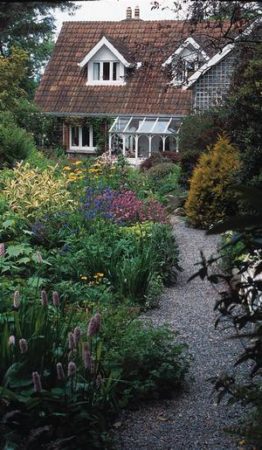
Formality
Click here to view bigger sized image
A combination of formality and informality is the best approach to garden design. The hard materials of the garden tend to be formal anyway and they can be allowed to bring some formality to the garden. Hard materials can have a formal informality – formality of texture, surface and shape and informality of line!
Plants are informal and they can be used to balance the formality of the hard parts. The combination gives a design of subtlety and strength.
Every design should have hard materials as well as plants. Among plants every garden must have trees for skeleton, evergreens for weight, shrubs and flowers for shape and colour. A few key ornaments should be used.


